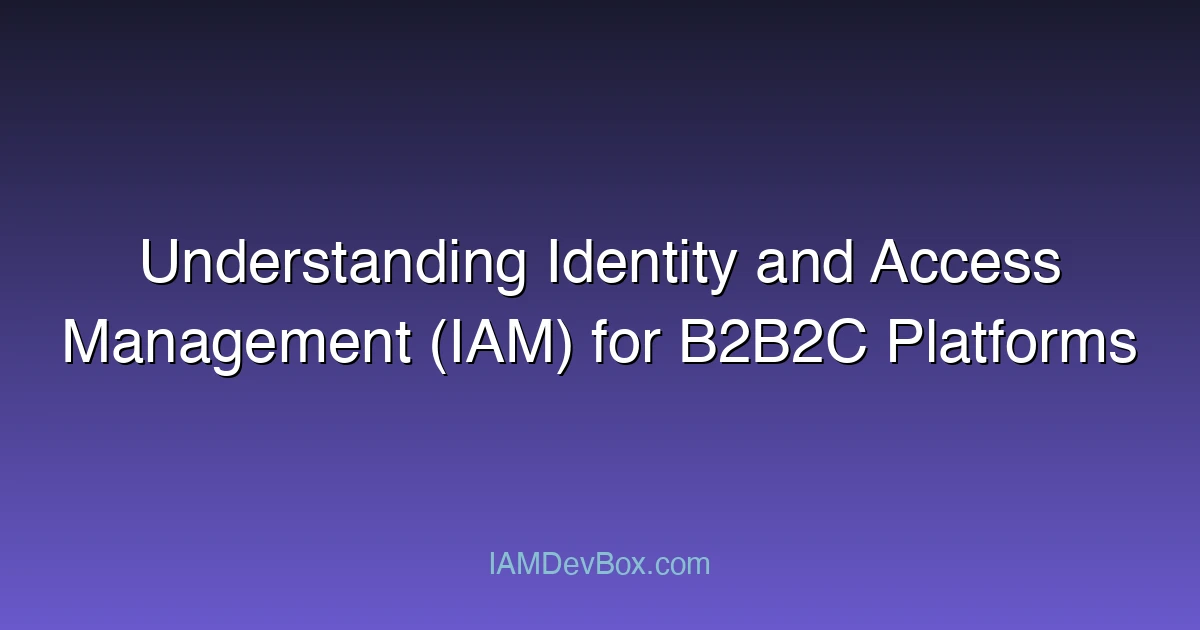Visual Overview:
graph LR
subgraph JWT Token
A[Header] --> B[Payload] --> C[Signature]
end
A --> D["{ alg: RS256, typ: JWT }"]
B --> E["{ sub, iss, exp, iat, ... }"]
C --> F["HMACSHA256(base64(header) + base64(payload), secret)"]
style A fill:#667eea,color:#fff
style B fill:#764ba2,color:#fff
style C fill:#f093fb,color:#fff
In the digital age, B2B2C (Business-to-Business-to-Consumer) platforms have emerged as a critical bridge between businesses and end-users. These platforms often operate in highly complex environments, where multiple stakeholders, including businesses, developers, and consumers, interact seamlessly. Identity and Access Management (IAM) plays a pivotal role in ensuring secure, scalable, and efficient operations for B2B2C platforms.
This blog post explores how IAM architectures can be tailored to meet the unique demands of B2B2C platforms, highlighting key design considerations, implementation strategies, and real-world use cases.
The Role of IAM in B2B2C Platforms
B2B2C platforms typically involve three main entities: the platform provider, the businesses (or tenants) that use the platform, and the end-users (consumers). Each of these entities has distinct identity and access requirements:
- Platform Providers need to manage their own administrative access and ensure compliance with regulatory standards.
- Tenants (Businesses) require secure access to platform APIs, dashboards, and other resources, often with granular permissions based on their roles.
- End-Users (Consumers) must be authenticated and authorized to access services or products provided through the platform.
IAM systems must address these diverse needs while maintaining scalability, security, and user experience.
Key Design Considerations for IAM in B2B2C Platforms
-
Multi-Tenant Architecture B2B2C platforms are inherently multi-tenant, meaning the IAM system must support multiple independent businesses operating on the same platform. Each tenant should have its own identity domain, allowing for customized roles, permissions, and authentication policies.
Flowchart: Multi-Tenant IAM Architecture
flowchart TD A[Platform Provider] -->|Defines Tenant Policies| B[Tenant Identity Domain] B -->|Manages Roles & Permissions| C[Tenant Users] C -->|Authenticates via OAuth| D[Platform API] D -->|Provides Consumer Access| E[End-User] -
Role-Based Access Control (RBAC) RBAC is essential for managing permissions across multiple stakeholders. For example, a tenant administrator might have different access levels compared to a regular tenant user.
Example RBAC Configuration
{ "tenant_id": "12345", "roles": ["administrator", "api_user"], "permissions": ["read", "write", "execute"] } -
Federated Identity Management Many B2B2C platforms integrate with third-party identity providers (e.g., Google, Microsoft, or OAuth providers). Federated identity management allows users to authenticate using their existing credentials, improving user experience and reducing friction.
-
API Security APIs are the backbone of B2B2C platforms, enabling communication between tenants and end-users. IAM must enforce secure API access, including token-based authentication (e.g., JWT) and rate limiting.
Implementing IAM for B2B2C Platforms
-
Identity Federation Implementing a federated identity system allows tenants to integrate their existing identity providers into the platform. This is particularly useful for large enterprises that prefer to maintain control over their user identities.
Example: OAuth 2.0 Integration
POST /oauth2/token Content-Type: application/x-www-form-urlencoded grant_type=client_credentials&client_id=tenant_123&client_secret=secret -
Multi-Tenant Tokenization Tokens issued by the IAM system must include tenant-specific information to enforce role-based access control. For example, a JWT token might include the tenant ID, user roles, and expiration time.
Example JWT Token
{ "tenant_id": "tenant_123", "user_id": "user_456", "roles": ["api_user"], "exp": 1625145600 } -
Audit and Logging Comprehensive audit logs are critical for compliance and troubleshooting. Logs should capture all authentication and authorization events, including failed attempts and policy changes.
Real-World Use Case: E-Commerce Platform
Consider an e-commerce platform that connects online marketplaces (tenants) with consumers. Each marketplace has its own set of sellers and buyers. The IAM system must:
- Authenticate marketplace administrators and sellers.
- Authorize API access for sellers to manage their product listings.
- Enable consumers to log in using their social media accounts.
Challenges and Future Trends
-
Scalability As the number of tenants and users grows, the IAM system must remain performant. This requires careful optimization of database queries, token validation, and API endpoints.
-
Regulatory Compliance B2B2C platforms often handle sensitive user data, making compliance with regulations like GDPR, CCPA, and PCI-DSS a top priority.
-
AI-Driven IAM Future advancements in AI and machine learning could enable predictive access management, where the system automatically adapts to user behavior and security threats.
Conclusion
IAM is the backbone of secure and efficient B2B2C platforms. By leveraging multi-tenant architectures, role-based access control, and federated identity management, organizations can build scalable and user-friendly platforms that meet the needs of businesses and consumers alike.
As you design your IAM system, ask yourself:
- How will I handle tenant-specific identity domains?
- What are the key security risks, and how can I mitigate them?
- How will I ensure compliance with evolving regulations?
By addressing these questions, you can create an IAM architecture that not only supports your platform today but also scales with your business in the future.
